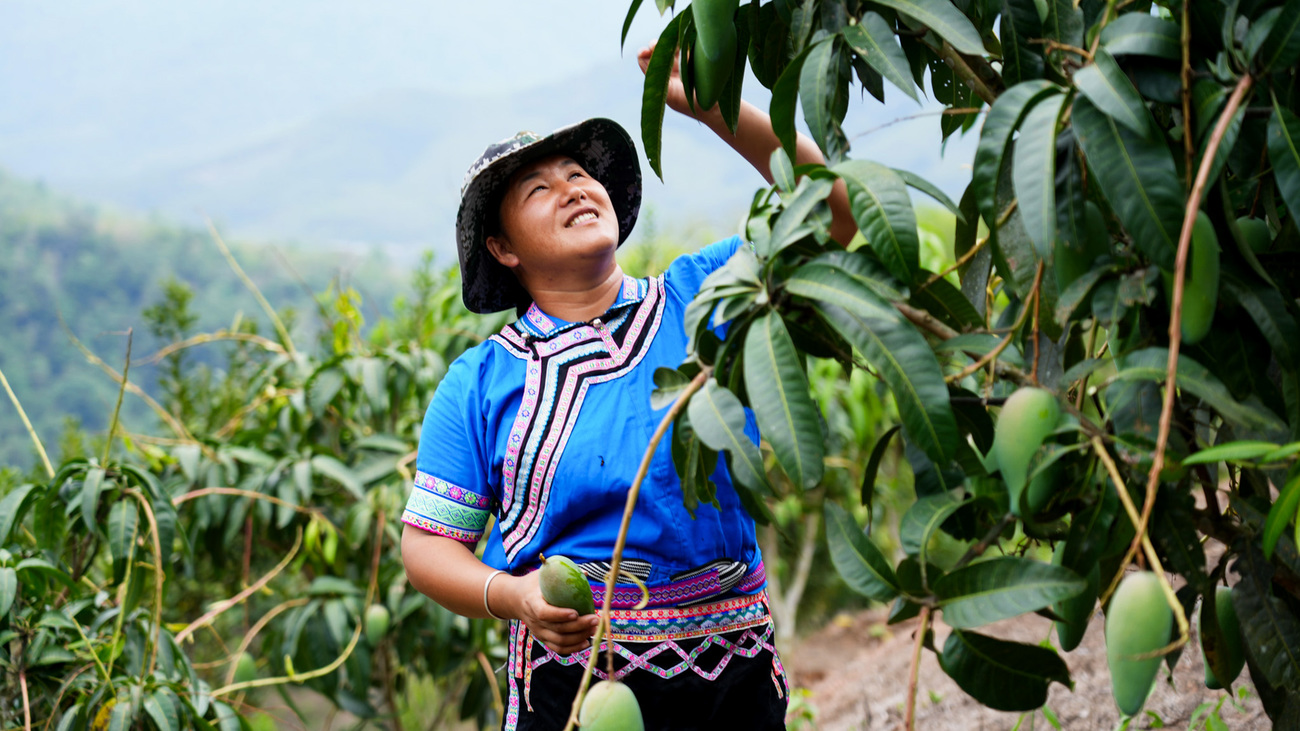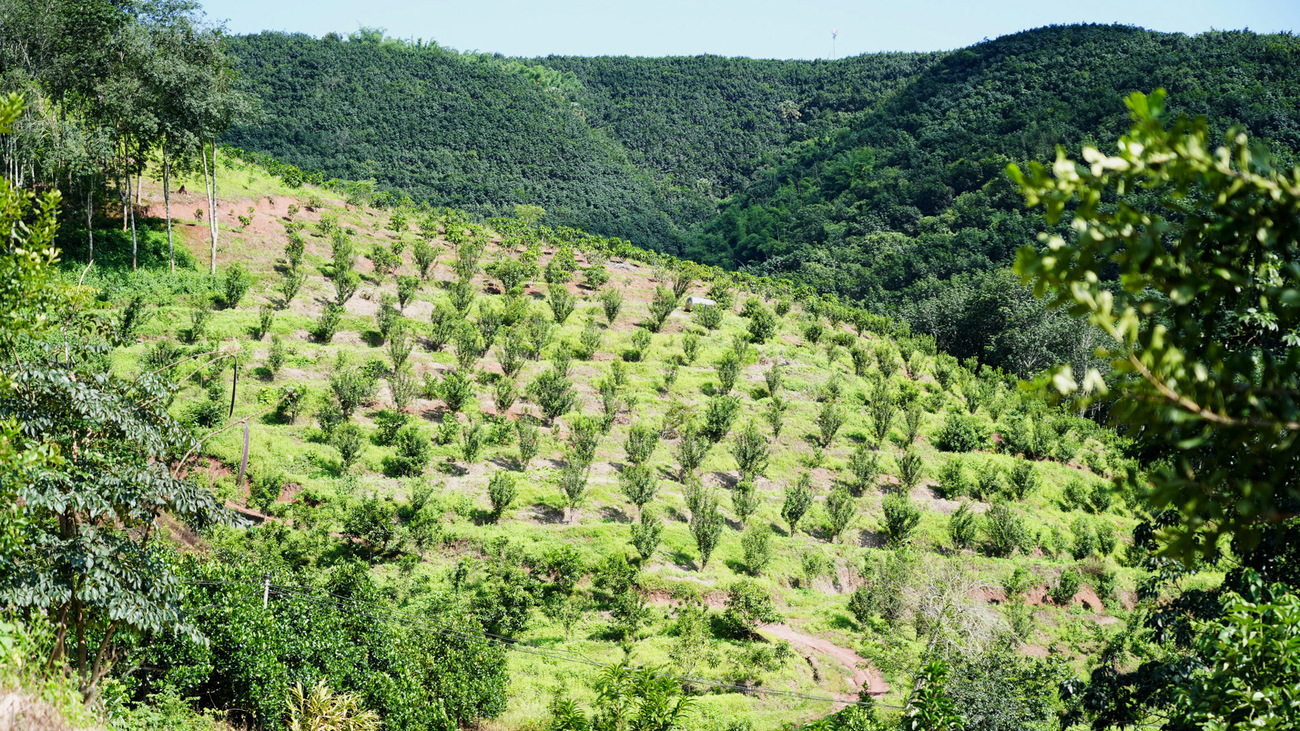Asian elephant protection – China
Conserving Asian elephant populations through coexistence initiativesA village grows mangoes at the heart of an ecological transformation
A village grows mangoes at the heart of an ecological transformation
Each summer, the rains return to Daotangqing Village, a mountainous area in Xishuangbanna, Yunnan Province, in southwestern China.
Morning mist settles gently on the mango orchards. Among the trees walks Zhang Jiangmei, stepping carefully along the soft ground. She wasn’t always a mango farmer. In fact, a few years ago, no one in this village had ever grown mangoes.

But when her community became part of a bold new conservation effort, her life and the land around her began to change.
Living with elephants by changing how we live
Daotangqing lies within the natural range of Asian elephants. For years, villagers worked in the surrounding forests planting rubber. This brought them closer than was safe to elephants, which raised the risk of human-wildlife conflicts that can prove deadly for both people and animals.
To protect elephants and help communities thrive alongside them, IFAW, in partnership with Swire Coca-Cola and the Rainforest Foundation, launched the Carbon Sequestration Community project in 2021. By replacing rubber with more sustainable crops like mangoes and macadamia nuts, the project introduced a different way to live. It offered training in ecological farming and reduced the need to work deep in the forest. It opened a path toward a future where people and elephants might share the land more peacefully. Zhang was among the first to join.
A leader grows from the roots up
At first, Zhang knew little about ecological farming. She had never heard the term ‘carbon reduction’. But with the project came experts, who introduced sophisticated technologies and novel implementation approaches.
Zhang learned and adopted practices that avoided herbicides and reduced chemical use. She let native vegetation grow beneath the trees. She worked with care and patience. Over time, she began helping other villagers understand the methods too.
As her confidence grew, so did her place in the community. In December 2024, she was elected village head. Inspiring and empowering her community, she leads change from within.
The work of many hands
This summer has been one of the village’s busiest yet. With the mangoes ripening, villagers are out early, picking, sorting, and packing.

In the orchards, Zhang works alongside Wang Shaokuan, one of the younger participants. Together, they guide others in selecting fruits of the right size and shape for shipment.
‘The mangoes we grow may not look as perfect as the ones that use chemicals,’ says Wang, inspecting a freshly picked fruit. ‘But they are clean, healthy, and grown the right way.’
Just a few years ago, none of these trees existed. Today, they represent a new source of income and an innovative way to coexist with wildlife.
A mango and a memory
Beekeeper Mr. Luo, now in his seventies, showed up just as the morning’s work was getting underway. He picked up a mango, turned it over in his hands, and said with a grin, ‘Last year, they put my picture on the cards that went into the boxes. Me, holding one of these.’
You could see the pride in his eyes. That photo had travelled far, reaching homes he would never visit, resting beside fruit grown right here in their orchards.
A layered approach to conservation
The Carbon Sequestration Community is more than an agricultural project. It is a carefully designed system that links biodiversity, rural development, and climate action.
So far, about 38 acres of rubber plantations have been replaced with eco-friendly orchards including mango, canistel, and macadamia. Wildlife-friendly planting methods are reducing fertilizer use and restoring native ground cover, all while protecting our wildlife neighbours, Asian elephants.
The project is expected to reduce 971 to 1,256 tCO2e of carbon dioxide over 15 years, with an annual average of 65 to 84 tCO2e.
Beekeeping has been introduced as a complementary livelihood, with 100 hives placed in a nearby community.
The project also supports clean energy. A 16-kilowatt solar panel system installed in the village has generated 31,900 kilowatt-hours since April 2022, reducing carbon emissions by about 32,000 kilograms. The revenue, around 15,000 yuan, goes directly to the village’s public fund.

This multi-layered approach is about more than numbers. It is about helping people stay close to home, work more safely, and reduce their dependence on the forest. In doing so, it creates room for elephants to roam.
Hope for the next harvest
The mango trees are still young. But with each passing season, they grow stronger, just like the people tending them.
The village feels different now. The air is cleaner. The land is more alive. There is a quiet pride in what is being built here.
Standing at the edge of the orchard, Zhang looks out over the green rows of trees ‘“We hope the trees will do even better next year,’ she says.
Here in Daotangqing, change is not loud or dramatic. It is steady, rooted in the soil, and carried forward by hands that have learned to live with the land, not against it.
Related content
every problem has a solution, every solution needs support.
The problems we face are urgent, complicated, and resistant to change. Real solutions demand creativity, hard work, and involvement from people like you.